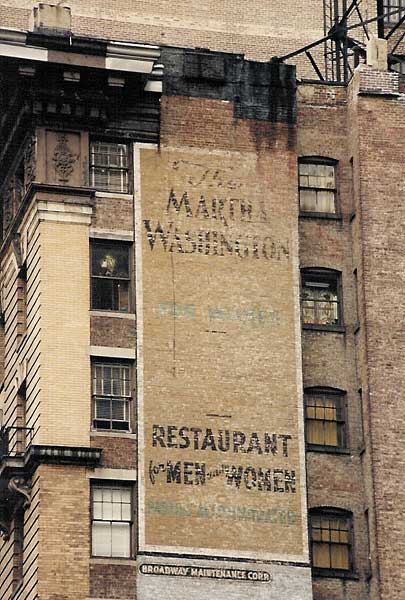
The Martha Washington Hotel, 29 E. 29th St. between Madison and Park Ave. South (1987)

The Martha Washington Hotel was built in 1902 (opened on 2 March 1903) as a hotel for women. But (as the sign says) men could eat in the restaurant.
The New Building Permit filed with the New York City Dept. of Buildings in 1901 specified that the building was to be a 12-story brick and stone hotel, 75 feet by 197 feet, and that costs were estimated at $350,000. The architect was Robert W. Gibson, 76 William St. (Office for Metropolitan History, "Manhattan NB Database 1900-1986," (4-June-2011), http://www.MetroHistory.com.)
It had entrances at 29 East 29th and 30 East 30th, and had 416 rooms.
The current (August 2003) hotel in this building calls itself Hotel Thirty Thirty
with its entrance at 30 E. 30th.
The 1910 U. S. Census listed Arthur W. Eager, age 47, born Massachusetts, as proprietor of the Martha Washington Hotel. He lived in the hotel with his wife, daughter, mother-in-law and one servant. In addition there were 177 other residents, most of whom were described as guests. Among these, however, were many described as either servants or workers. Typical occupations among the guests were teacher, music teacher, interior decorator, artist advertising co., manufacturer gowns, cloak model, private secretary bank, stenographer office, clerk publishing house, and editor magazine.
A. W. Eager appears as the propietor of the Martha Washington in this ad from the American Review of Reviews, June, 1908.
This ad for the Martha Washington appeared in the Hotel Gazette 31 July 1915. Click here for Manger Hotels ad (from 1933/4) that includes The Martha Washington. An earlier Manger ad (from 1925) mentions lower rates ($1.50 daily, with an extra 50 cents for the private bath). Things had changed dramatically by 1988 when this ad appeared in the New York Times.
The hotel no doubt housed many notables in its day. One was the actress Louise Brooks who, in 1924, after an "humiliating eviction" from the Algonquin Hotel, moved to the Martha Washington, "a respectable woman's hotel on East Twenty-ninth Street" (quoting Louise Brooks, Lulu in Hollywood, 1974). "The atmosphere of the Martha Washington Hotel was institutional. The women wore short hair, suits, and sensible shoes, and worked, I assumed, in offices." Louise was "assigned a cell under the roof," but she did not stay long: "I was asked to leave the Martha Washington, because people in a building overlooking the hotel had been shocked to see me on the roof, exercising in 'flimsy pajamas.'"
The New York Public Library's Digital Collections contain a postcard of the Martha Washington mailed 4 April 1907 (click for image). The view is from the west (Madison Ave.). My view above is from the east (4th Ave.). This postcard view, like the NYPL image, is from the west.
The Martha Washington was listed in Rider's New York City: A Guide-Book for Travelers, compiled and edited by Fremont Rider, 1916, as, "Martha Washington, 29 E. 29th st. (450 R. [rooms]) For women; men admitted to restaurant and tea room, otherwise like any other well-conducted hotel." The rates were $1.50 for room with hot water, $3 with bath, $2.50 double with hot water, and $4 double with bath. They also offered weekly rates.
The 1920 U. S. Census recorded 258 people living at the Martha Washington. This included William P. Merritt, manager, and six other males, with positions like porter, laborer and dishwasher. There was also the 23-year-old son of Mrs. W. Y. Lawlor. Edward R. Lawlor seems to have been the only non-employee resident who was an exception to the women-only rule.
The architect, Robert Williams Gibson (1854-1927), is described in a brief wikipedia article as "an English-born American ecclesiastical architect." The Martha Washington is not included among his works. Instead, the article lists the 1905 Morton F. Plant House at 651 Fifth Ave., southeast corner of 52nd St., which since 1917 has been a Cartier jewelry store. The AIA Guide to New York City, 4th ed., 2000, by Norval White and Elliot Willensky, lists the Plant House, as well as St. Michael's Church (1891) at the corner of 99th St. and Amsterdam Ave., the West End Collegiate Church and School (1891-1893), and the Museum Building, New York Botanical Garden (1902), among Gibson's New York City designs.
< previous || next > index map signs by date signs by name see what's new